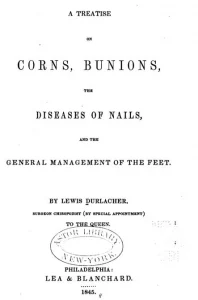
A Treatise on Corns, Bunions, the Diseases of Nails, and the General Management of the Feet by Lewis Durlacher from 1845 is one of the classics that underpins the profession of podiatry.
Table of Contents for A Treatise on Corns, Bunions, the Diseases of Nails, and the General Management of the Feet
1. The Cause and Growth of Corns
2. Hard Corns
3. Callosities
4. Soft Corns
5. Festered Corns
6. Neurovascular Corns
7. Vascular Excresence
8. Bunions
9. Nails and Their Diseases
10. The Management of the Finger Nails
11. Warts
12. Chilblains
13. The Management of the Feet
Lewis Durlacher is most well known for the corn named after him, the Durlacher’s Corn
What is a Durlacher’s Corn?















